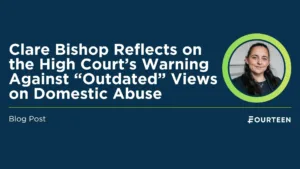
The decision to hold a fact-finding hearing is an incredibly important decision in any case where allegations of domestic abuse are raised. These allegations often appear in tandem with counter-allegations of domestic abuse or, in some cases, parental alienation.
The decision to hold a separate fact-finding hearing is often made in a short one hour hearing amongst other cases in a busy judge’s list. Nevertheless, what should be at the forefront of the court’s mind is that the purpose of a fact-finding hearing is to provide a risk assessment and assess the impact of any allegations of abuse on the parent and/or the child or children.
However, as the Guardian article makes clear it is unhelpful and insensitive to describe incidents of domestic abuse as historical especially in cases where the allegations are only four years old and in cases where there are allegations of coercive or controlling behaviour. This stark caution has been given on appeals by High Court judges on multiple occasions. For example, the Court of Appeal at paragraph 52 of Re H-N (Children) (Domestic Abuse: Finding of Fact Hearings) concluded that:
“The approach regarding coercive or controlling incidents that occurred between the adults when they were together in a close relationship as being ‘in the past’, and therefore of little or no relevance in terms of establishing a risk of future harm, should, we believe, also be considered to be ‘old fashioned’ and no longer acceptable. The fact that there may in the future be no longer any risk of assault, because an injunction has been granted, or that the opportunity for inter-marital or inter-partnership rape may no longer arise, does not mean that a pattern of coercive or controlling behaviour of that nature, adopted by one partner towards another, where this is proved, will not manifest itself in some other, albeit more subtle, manner so as to cause further harm or otherwise suborn the independence of the victim in the future and impact upon the welfare of the children of the family.
Interestingly, the recent report in October 2025 by the Domestic Abuse Commissioner entitled “Everyday Business: Addressing Domestic Abuse and Continuing Harm Through a Family Court Review and Reporting Mechanism” concludes that domestic abuse continues to be marginalised and minimised by the courts and children’s voices remain muted. Of particular note the report concluded that:
“Evidence of abuse is ignored, minimised or dismissed and survivors are discouraged from pursuing allegations. Few fact-finding hearings are actually held and those that proceed tend to centre around allegations of physical and/or sexual abuse, itemised and decontextualised in Scott Schedules, rather than on patterns of controlling and coercive behaviour. Lack of judicial continuity also makes it difficult or impossible for judicial officers to see patterns of abusive behaviour in the cases before them”.
The real difficulty in these cases is when a small minority of judges make comments which are outdated and represent attitudes that are no longer accepted within contemporary society. The underlying reason for this is known. Some may say it is due to insufficient training on domestic abuse whilst others may attribute this to the attitudes of a very small number of judges and that this is not representative of judges as a whole.
A further possibility is that judges see the same allegations daily and have become “case hardened”. This may allow their own thinking to be dominated by a single idea rather than looking at the case holistically. Therefore, there needs to be further exploration of how consistency within judicial decision-making can be achieved; whether this is through more intense training in domestic abuse, the way judges are recruited including a more thorough assessment of their attitudes or more regular appraisals of judges throughout their career in order to prevent the same mistakes repeating themselves.